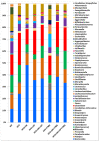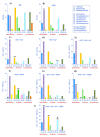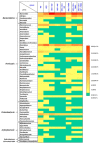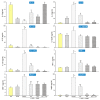The Combination of Intestinal Alkaline Phosphatase Treatment with Moderate Physical Activity Alleviates the Severity of Experimental Colitis in Obese Mice via Modulation of Gut Microbiota, Attenuation of Proinflammatory Cytokines, Oxidative Stress Biomarkers and DNA Oxidative Damage in Colonic Mucosa
- PMID: 35328382
- PMCID: PMC8955215
- DOI: 10.3390/ijms23062964
The Combination of Intestinal Alkaline Phosphatase Treatment with Moderate Physical Activity Alleviates the Severity of Experimental Colitis in Obese Mice via Modulation of Gut Microbiota, Attenuation of Proinflammatory Cytokines, Oxidative Stress Biomarkers and DNA Oxidative Damage in Colonic Mucosa
Abstract
Inflammatory bowel diseases (IBD) are commonly considered as Crohn's disease and ulcerative colitis, but the possibility that the alterations in gut microbiota and oxidative stress may affect the course of experimental colitis in obese physically exercising mice treated with the intestinal alkaline phosphatase (IAP) has been little elucidated. Mice fed a high-fat-diet (HFD) or normal diet (ND) for 14 weeks were randomly assigned to exercise on spinning wheels (SW) for 7 weeks and treated with IAP followed by intrarectal administration of TNBS. The disease activity index (DAI), grip muscle strength test, oxidative stress biomarkers (MDA, SOD, GSH), DNA damage (8-OHdG), the plasma levels of cytokines IL-2, IL-6, IL-10, IL-12p70, IL-17a, TNF-α, MCP-1 and leptin were assessed, and the stool composition of the intestinal microbiota was determined by next generation sequencing (NGS). The TNBS-induced colitis was worsened in obese sedentary mice as manifested by severe colonic damage, an increase in DAI, oxidative stress biomarkers, DNA damage and decreased muscle strength. The longer running distance and weight loss was observed in mice given IAP or subjected to IAP + SW compared to sedentary ones. Less heterogeneous microbial composition was noticed in sedentary obese colitis mice and this effect disappeared in IAP + SW mice. Absence of Alistipes, lower proportion of Turicibacter, Proteobacteria and Faecalibacterium, an increase in Firmicutes and Clostridium, a decrease in oxidative stress biomarkers, 8-OHdG content and proinflammatory cytokines were observed in IAP + SW mice. IAP supplementation in combination with moderate physical activity attenuates the severity of murine colitis complicated by obesity through a mechanism involving the downregulation of the intestinal cytokine/chemokine network and oxidative stress, the modulation of the gut microbiota and an improvement of muscle strength.
Keywords: diet-induced obesity; experimental colitis; inflammation; intestinal alkaline phosphatase; oxidative stress; voluntary exercise.
Conflict of interest statement
The authors declare no conflict of interest.
Figures














Similar articles
-
Alkaline Phosphatase Relieves Colitis in Obese Mice Subjected to Forced Exercise via Its Anti-Inflammatory and Intestinal Microbiota-Shaping Properties.Int J Mol Sci. 2024 Jan 5;25(2):703. doi: 10.3390/ijms25020703. Int J Mol Sci. 2024. PMID: 38255781 Free PMC article.
-
Effect of Forced Physical Activity on the Severity of Experimental Colitis in Normal Weight and Obese Mice. Involvement of Oxidative Stress and Proinflammatory Biomarkers.Nutrients. 2019 May 21;11(5):1127. doi: 10.3390/nu11051127. Nutrients. 2019. PMID: 31117199 Free PMC article.
-
Intestinal Alkaline Phosphatase Combined with Voluntary Physical Activity Alleviates Experimental Colitis in Obese Mice. Involvement of Oxidative Stress, Myokines, Adipokines and Proinflammatory Biomarkers.Antioxidants (Basel). 2021 Feb 4;10(2):240. doi: 10.3390/antiox10020240. Antioxidants (Basel). 2021. PMID: 33557311 Free PMC article.
-
Alternative Therapy in the Prevention of Experimental and Clinical Inflammatory Bowel Disease. Impact of Regular Physical Activity, Intestinal Alkaline Phosphatase and Herbal Products.Curr Pharm Des. 2020;26(25):2936-2950. doi: 10.2174/1381612826666200427090127. Curr Pharm Des. 2020. PMID: 32338209 Review.
-
Development, validation and implementation of an in vitro model for the study of metabolic and immune function in normal and inflamed human colonic epithelium.Dan Med J. 2015 Jan;62(1):B4973. Dan Med J. 2015. PMID: 25557335 Review.
Cited by
-
Exploration of the Gut Microbiome in Thai Patients with Major Depressive Disorder Shows a Specific Bacterial Profile with Depletion of the Ruminococcus Genus as a Putative Biomarker.Cells. 2023 Apr 25;12(9):1240. doi: 10.3390/cells12091240. Cells. 2023. PMID: 37174640 Free PMC article.
-
Intestinal Alkaline Phosphatase: A Review of This Enzyme Role in the Intestinal Barrier Function.Microorganisms. 2022 Mar 30;10(4):746. doi: 10.3390/microorganisms10040746. Microorganisms. 2022. PMID: 35456797 Free PMC article. Review.
-
Revitalizing the Gut Microbiome in Chronic Kidney Disease: A Comprehensive Exploration of the Therapeutic Potential of Physical Activity.Toxins (Basel). 2024 May 26;16(6):242. doi: 10.3390/toxins16060242. Toxins (Basel). 2024. PMID: 38922137 Free PMC article. Review.
-
Natural flavones from edible and medicinal plants exhibit enormous potential to treat ulcerative colitis.Front Pharmacol. 2023 Jun 1;14:1168990. doi: 10.3389/fphar.2023.1168990. eCollection 2023. Front Pharmacol. 2023. PMID: 37324477 Free PMC article. Review.
-
Alkaline Phosphatase Relieves Colitis in Obese Mice Subjected to Forced Exercise via Its Anti-Inflammatory and Intestinal Microbiota-Shaping Properties.Int J Mol Sci. 2024 Jan 5;25(2):703. doi: 10.3390/ijms25020703. Int J Mol Sci. 2024. PMID: 38255781 Free PMC article.
References
-
- Bilski J., Mazur-Bialy A., Wojcik D., Magierowski M., Surmiak M., Kwiecien S., Magierowska K., Hubalewska-Mazgaj M., Sliwowski Z., Brzozowski T. Effect of forced physical activity on the severity of experimental colitis in normal weight and obese mice. Involvement of oxidative stress and proinflammatory biomarkers. Nutrients. 2019;11:1127. doi: 10.3390/nu11051127. - DOI - PMC - PubMed
-
- Barbosa M.M.C., Vicentini F.A., Castro-Ghizoni C.V., Lameira O.A., Sa-Nakanishi A.B., Bracht L., Peralta R.M., Natali M.R.M., Bracht A., Comar J.F. Copaiba Oil Decreases Oxidative Stress and Inflammation But not Colon Damage in Rats with TNBS-Induced Colitis. Endocr. Metab. Immune Disord.-Drug Targets. 2018;18:268–280. doi: 10.2174/1871530318666180215102029. - DOI - PubMed
MeSH terms
Substances
Grants and funding
LinkOut - more resources
Full Text Sources
Research Materials
Miscellaneous

